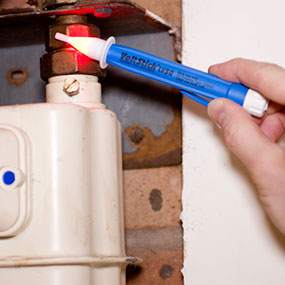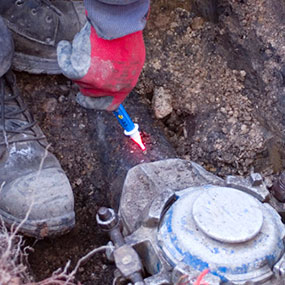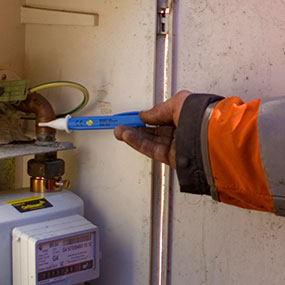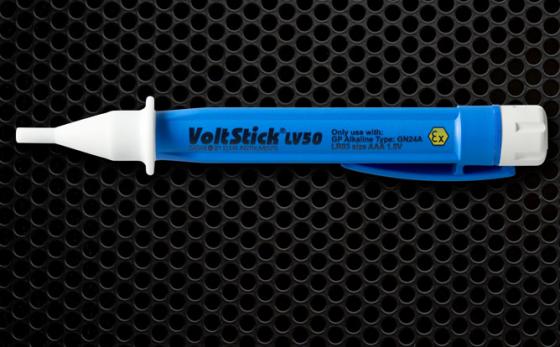Electrical Safety Checks for Gas Engineers using Volt Stick LV50
The Volt Stick LV50 is the only instant voltage tester approved by Cadent for electrical safety testing by gas engineers.

In 1998, a gas utility engineer attended a residential property in response to a reported gas emergency. Whilst attempting to gain access to a gas meter which was installed underneath the kitchen sink of the property, the engineer placed his hand on the sink and the emergency control valve.
Due to a fault on the property’s electrical installation, the engineer received a significant electric shock which – tragically – proved fatal.
This guide has been developed specifically for gas engineers and will explain how to identify electrical hazards and how to work in a correct and safe manner using this life-saving, testing device; the Volt Stick LV50 instant voltage indicator.
This guide covers the following subjects:
- Enabling Cadent personnel, sub contractors and all gas engineers to work safely and detect the presence of an AC voltage on bare metal pipework, fittings and appliances.
- Understand the operation of this life-saving safety device – the Volt Stick LV50.
- Be aware of the limitations of the device’s operation – and how to address these limitations
- Understand the maintenance requirements of the Volt Stick
- …and to understand the relevant safety requirements related to the Volt Stick’s operation
What is a Volt Stick?
 Similar in size to a pen, Volt Sticks provide a convenient safety-checking device which can instantly detect the presence of a dangerous – potentially fatal – AC voltage, without the need to make physical contact with any potentially conducting surfaces or materials.
Similar in size to a pen, Volt Sticks provide a convenient safety-checking device which can instantly detect the presence of a dangerous – potentially fatal – AC voltage, without the need to make physical contact with any potentially conducting surfaces or materials.
These simple-to-use, instant voltage testers provide an essential, life-saving device for anyone likely to come into contact with energised components or materials.
Metal pipes, enclosures, cables and fittings are all possible electrical safety hazards – and a Volt Stick will instantly answer that first, most vital, question – ‘Is dangerous voltage present?’
How does a Volt Stick work?
Volt Stick instant voltage indicators detect the electrical field emitted from an object with an AC voltage across it – by using the principal of ‘capacitive coupling’.
Or, in very simple terms – hold the Volt Stick close to any object or surface which could be a potential hazard and – if an AC voltage is detected – the tip of the Volt Stick LV50 will illuminate red; it’s that simple!
Why use the Volt Stick LV50 device?
The Volt Stick LV50 is the only instant voltage detector approved by Cadent and is a mandatory device for all Cadent engineers and sub-contracted engineers.
(It is, therefore, also recommended as a vital life-safety checking device for all gas engieers working on site).
After referring to the Health & Safety Executive’s guidance – HSG85, which states a safe threshold for touch potential of 50 volts – Cadent approached Volt Stick to develop a specific 50 volt sensitised version of the detector which was safe to use in gaseous environments.
Frequently required for outdoor use, the Volt Stick LV50 is weatherproof, but not waterproof.
Essential for use in potentially hazardous or gaseous environments, the Volt Stick LV50 is both ATEX and IECEx certified to be intrinsically safe.
Therefore, the Volt Stick LV50 was designed to be – and remains as – the safest, most reliable way to quickly check your work environment for any stray or unexpected voltages of 50 volts AC or above on any pipes, meters, or metallic surfaces.
How to use the Volt Stick LV50
-
 All metallic surfaces within a work environment must first be tested using a Volt Stick LV50, before touching any metal devices, metal covers or surfaces.
All metallic surfaces within a work environment must first be tested using a Volt Stick LV50, before touching any metal devices, metal covers or surfaces. - Before testing the work environment, check the Volt Stick is working correctly against a known live source – importantly, within the area you are about to work.
- If there are no live sockets or switches in your immediate work area, check the Volt Stick against the nearest known live source.
-
If the Volt Stick doesn’t illuminate when tested, move out of the gaseous area and check the Volt Stick by unscrewing the end cap and replacing the triple-A batteries.
NOTE – only use the approved batteries (other non-approved batteries will invalidate the ATEX and IECEx certification).
- ONLY trust the Volt Stick if you have successfully proved it against a known live source in your work area first!
- Faulty or damaged Volt Sticks must not be used and must be replaced immediately.
Having successfully proved your device...
- To operate the Volt Stick LV50, hold the unit by the blue body and not the white tip.
- In order to ensure safe testing, only the white tip of the Volt Stick can make contact with any metalwork.
- Should an AC voltage of 50 volts or above be detected, the white tip of the Volt Stick will illuminate red.
- Be sure to check all metal surfaces with the tip of the Volt Stick.
- …and be careful not to touch any metalwork with any other part of your body.
Other metalwork that is in close contact to electrical cables – including metalwork connected by earth boding cables – should also be tested before it is touched.
If the Volt Stick illuminates when testing a metallic surface, then this is indicating the probable presence of a potentially dangerous voltage of 50 volts or above.
Other reasons why the Volt Stick will illuminate:
There are a small number of situations or influences which may also cause the Volt stick LV50 to indicate the presence of a voltage and, if the Volt Stick provides a positive indication, you must always assume it is an actual indication of a dangerous voltage presence until all other possibilities are ruled out.
-
The Volt Stick LV50 may also indicate red if it is in close proximity to insulated cables.
In this case, test the same metalwork further away from the cables if possible. If the Volt Stick no longer indicates red, then the metalwork is not carrying a 50 volt + AC voltage.
-
The Volt Stick can illuminate red if you are standing on or leaning against – or even in close proximity to – electric cables. These may be exposed, but they could be hidden in a wall or under the floor.
Be aware of your surroundings and move your body away from areas you may suspect have hidden cabling.
The electric field from hidden cabling can capacitively couple with your body and make the Volt Stick illuminate when it is moved closer to a metallic object.
If the Volt Stick stops illuminating when you move away, then you are probably picking up a field from hidden cabling.
-
Your Volt Stick may also provide a indicate red due to the electric field from overhead light fittings.
Be aware if you are standing underneath lighting – particularly fluorescent tubes – they give off an electric field that can again couple with your body and cause the Volt Stick to illuminate as it is moved towards the metallic object you are testing.
Try to move away from the light fitting and see if the Volt Stick stops illuminating when it is moved towards the metallic object again.
- And finally, there is a small chance that a Volt Stick will illuminate on some statically-charged materials such as plastics or aluminium.
However, it is essential to assume that if your Volt Stick illuminates, then there is a potentially dangerous voltage within the work space.
If in doubt - do not touch any metalwork and consult an expert.
If a voltage is detected on any metalwork within the work area:
- Isolate the fuse to stop the indication
- Label the fuse
- Advise the customer of the next steps to be taken
Once you have fully tested your workspace and the Volt Stick LV50 has confirmed there to be no 50 volt or above AC voltage present on any of the exposed metalwork, what else do you need to consider?
What about voltages below 50v AC?
Although these are below the lethal threshold, they still pose a potential danger if present.
Very low voltages that are undetectable by the Volt Stick can still have enough energy to cause a spark and an explosion!
Therefore it is essential that a temporary continuity bond must be fitted before separating or disconnecting any pipework or fittings.
...and finally, once your work is finished, always check your Volt Stick again against a known live source.
How to use the Volt Stick LV50 Summary
- The Volt Stick LV50 is mandatory for Cadent engineers and sub-contractors - and is recommended as a vital safety testing device for all gas engineers - working on site
-
 This test device is there for your safety against any dangerous - potentially fatal - unexpected voltages
This test device is there for your safety against any dangerous - potentially fatal - unexpected voltages - Always use the Volt Stick prior to touching any exposed metalwork
- Only hold the blue body, not the white tip, of the device
- The only contact with exposed metalwork should be via the tip of the Volt Stick
- When testing your Volt Stick, do not touch any other metalwork with any part of your body
- Your Volt Stick should always be tested before and after each job
- Any faulty or damaged Volt Sticks should never be used and should be replaced immediately
Volt Stick LV50 is used by all 4 of the UK's major gas distribution network operators - Cadent, SGN, Northern Gas Networks and Wales & West.

More questions about Volt Stick LV50 or electrical safety checks for gas engineers?
If you have any questions regarding the use of the Volt Stick LV50, or safe electrical checks for on-site gas engineers, please contact the Volt Stick team by emailing us at info@voltstick.com
Read more:









